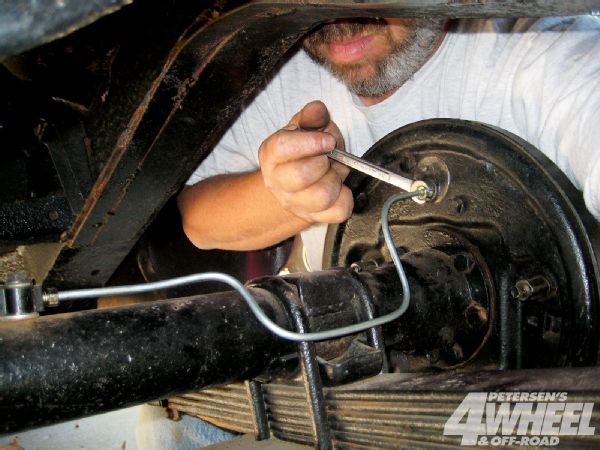
The dirtier the work is, the more important the job usually is. Brake work falls into this category: DOT 3 brake fluid bubbles paint; air in the brake system can be hard to remove; and many fittings, cylinders, blocks, and valves mean many potential leak spots. But without properly functioning brakes, we're more over the cliff than up the creek.
 Axle swaps and disc-brake conversions often require custom brake lines. For rock buggies and competition vehicles, fabricated lines come with the territory.
Axle swaps and disc-brake conversions often require custom brake lines. For rock buggies and competition vehicles, fabricated lines come with the territory.
Our focus here is on hard lines. Forming and flaring tubing requires some skill, but the tools are affordable enough that the competent do-it-yourselfer can normally handle the job with some practice. Also, aftermarket suppliers such as Classic Tube have all of the tubing, fittings, valves, and hardware necessary to build hard lines from the ground up. (The entire brake system should be designed before beginning line work: tubing diameter, routing, and nut styles are determined by disc/drums, master cylinders, and the various valves and blocks.)
Tubing Styles
Prebent: OE replica lines are available for most popular line-replacement jobs in both OE steel or upgraded stainless steel.
Straight Sticks: Mail-order brake specialists and many parts stores have preassembled (flared with nuts) pieces of straight brake line in varying lengths. UPS shipping limits length to 6 feet, and longer pieces often have a shipping bend to fit into a shorter box. The customer must straighten these bends.
Cut to Order: Tubing can also be ordered in custom lengths, often priced by the inch.
Rolls: For complete custom hard-line jobs, bulk rolls of tubing can be the most economical solution. OE steel is available in rolls up to 25 feet; stainless-steel rolls are typically 20 feet. Customers must straighten the coils with an appropriate tool or by hand: basically rolling the tubing on a flat surface like a kid making Play-Doh worms.
Tubing Diameter: For light-duty vehicles, systems having discs typically use 3/16-inch line while quad drums often have 1/4-inch line; 3/16 has a higher burst strength to better handle the approximately 1,000-psi pressure required to actuate calipers. (Wheel cylinders function more in the 300-psi range.)
PhotosView SlideshowMetallurgy
Brake lines come in two popular materials.
OE Tin-Coated Steel: Popular and enduring, these lines are made from low-carbon, continuously welded steel. Some manufacturers such as Classic Tube add galvanizing and an aluminum-epoxy topcoat to deter corrosion.
Stainless Steel: Approximately 25 percent more expensive than OE steel, stainless normally outlasts the vehicle. It's a good choice for NMRA mud boggers and Sippy Hole swamp buggies. Stainless has a reputation for being brittle and hard to flare, but many aftermarket suppliers use a softer ASTM grade for easier cutting, bending, and flaring without cracking. (Aluminum is fine for fuel lines, but it doesn't have the burst strength required for braking.)
Hardware
Aftermarket brake specialists have all the hardware necessary to plumb custom brake lines. These include axle blocks, line clamps, pressure valves, banjo fittings, unions, and adapters.
Ferrule Nuts: Choices are OE color-coded steel or 304 stainless, both available in SAE and metric threads. SAE threads were standard on American vehicles from World War II into the '70s. However, metric nuts are common on more-recent vehicles, which tend to use master cylinders and other components sourced from Europe and Asia.
Stainless steel nuts are ideal for custom 4x4 hard lines. These nuts won't rust-weld themselves to other components and tend to seat better than oxidation-attracting OE steel.
PhotosView SlideshowFabrication
The photos and captions here give an overview of building custom hard-lines. Classic Tube was our one-stop source for the parts and special tools required to create professional results at home.
Bending, cutting, and flaring are the three main hard-line maneuvers. Of these, flaring is the most intimidating. SAE 45-Degree Double Flare is standard for most mass-production American automotive applications. It seals in two places: on the outer lip and on the inner 45-degree bevel. Military AN 37-Degree Single Flare usually needs adapters and support sleeves in addition to nuts to mate to automotive components. ISO Bubble Flare is a third style, common on European vehicles.
Proper flaring is crucial for leak-free sealing. Follow the flaring tool's directions. (Never use pipe dope or Teflon tape on flared brake fittings. For optimal sealing between new line and old components, loosen and retighten the nut several times to create a tight seat.)
PhotosView SlideshowClean cutting and deburring ensure a good flare. Dull tubing cutters can booger the tubing and work-harden the stainless steel tube. Deburring and chamfering the tube prep it for a smooth, crack-free flare.
As with most things, practice makes perfect. Brakes (and steering) aren't learn-on-the-fly systems, so practice on pieces of scrap tubing until confident enough to do the real deal.
Fabbing hard lines isn't the easiest job, but for custom 4x4s it's one of the most critical.
Recommended Tools
•Tubing bender, a lever-type tool preferable to springs and box wrenches
•Double flaring kit. Some parts stores still rent or loan flaring kits. Fancy kits have hydraulic assist.
•Brake hose clamp
•Pressure bleeder for one-person bleeding
•Line wrenches











 PhotosView Slideshow
PhotosView Slideshow


